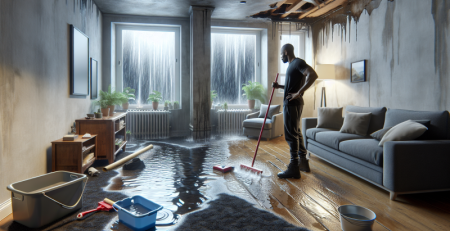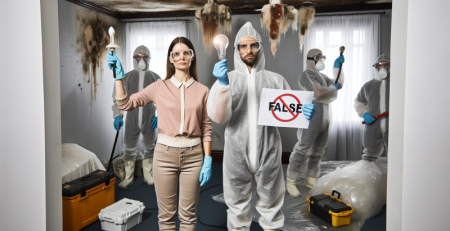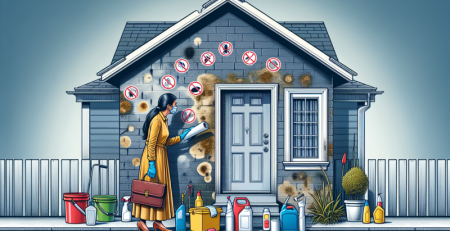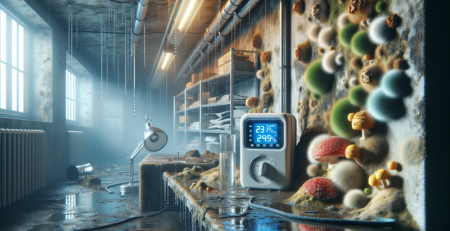Seasonal Tips for Preventing Water Damage
As the seasons change, so do the risks of water damage to your home. Whether it’s heavy spring rains, summer storms, or winter snowmelt, each season presents unique challenges that can lead to costly repairs and disruptions. At Kraus Restoration, NJ’s leaders in water, mold, and fire damage restoration, we understand the importance of being proactive in preventing water damage. Our team of IICRC certified experts is here to provide you with essential seasonal tips to safeguard your property. With our 24/7 emergency services and rapid response, you can trust us to help you protect your home throughout the year. Serving Central and Northern NJ, we are just a call away at (973) 886-2021. Stay informed and prepared with our expert advice to keep your home safe from water damage all year round.
Understanding the Risks of Seasonal Water Damage
Seasonal water damage is a significant concern for homeowners and property managers alike. Understanding the risks associated with water damage during different seasons can help you take proactive measures to protect your property. Water damage can occur due to various factors, including heavy rainfall, melting snow, and even humidity. Each season presents unique challenges that can lead to water-related issues if not properly managed.
In spring, the melting of snow and increased rainfall can overwhelm drainage systems, leading to flooding in basements and crawl spaces. According to the Federal Emergency Management Agency (FEMA), flooding is one of the most common and widespread natural disasters in the United States. In fact, about 20 percent of flood insurance claims come from properties outside high-risk flood zones. This statistic underscores the importance of being prepared for potential water damage, regardless of your location.
Summer brings its own set of risks, particularly in regions prone to thunderstorms and hurricanes. Heavy downpours can lead to flash flooding, which can cause significant damage to homes and businesses. The National Oceanic and Atmospheric Administration (NOAA) reports that flash floods are responsible for more fatalities than any other thunderstorm-related hazard. Homeowners should ensure that gutters and downspouts are clear of debris to facilitate proper drainage and reduce the risk of water pooling around the foundation.
As autumn arrives, leaves falling from trees can clog gutters and drainage systems, leading to water backup and potential leaks. It is essential to regularly clean gutters and downspouts to prevent water from accumulating on the roof and causing damage. Additionally, the transition to cooler temperatures can lead to frozen pipes, which can burst and cause extensive water damage. According to the Insurance Information Institute, water damage claims related to frozen pipes can average around $5,000 per incident.
Winter poses its own challenges, particularly in areas that experience heavy snowfall. The weight of snow on roofs can lead to structural damage, and as temperatures fluctuate, melting snow can create ice dams that prevent proper drainage. Ice dams can cause water to back up under shingles, leading to leaks and water damage inside the home. It is crucial to monitor snow accumulation on roofs and take action to remove it when necessary.
To mitigate the risks of seasonal water damage, homeowners should consider implementing several preventive measures. Regular maintenance of gutters, downspouts, and drainage systems is essential. Homeowners should also inspect their roofs for any signs of damage or wear and tear, as well as ensure that windows and doors are properly sealed to prevent water intrusion.
In addition to these preventive measures, it is wise to have a comprehensive water damage response plan in place. This plan should include knowing how to shut off the main water supply in case of a burst pipe and having contact information for a reliable water damage restoration service. Being prepared can significantly reduce the impact of water damage on your property.
In conclusion, understanding the risks associated with seasonal water damage is crucial for homeowners and property managers. By being aware of the potential hazards each season brings and taking proactive steps to mitigate these risks, you can protect your property from costly water damage. Regular maintenance, inspections, and a solid response plan are key components in safeguarding your home against the unpredictable nature of seasonal weather.
For more information on how to protect your property from water damage, consider visiting our water cleanup services page. If you want to learn more about our mold cleanup services, we can help you address any issues that may arise from water damage. For any inquiries, feel free to reach out through our contact page.
For further reading on the topic, you can explore resources from FEMA on flood preparedness and the NOAA for weather-related safety tips. Understanding these risks and taking action can help you maintain a safe and secure environment in your home throughout the year.
Preparing Your Home for Spring Thaws
As winter fades and spring approaches, homeowners must prepare for the inevitable thawing of snow and ice. This seasonal transition can bring about significant challenges, particularly concerning water damage. Proper preparation is essential to safeguard your home from the potential risks associated with melting snow and heavy spring rains. Here are several key steps to ensure your home is ready for the spring thaw.
First and foremost, inspect your roof and gutters. Winter weather can take a toll on your roofing system, leading to potential leaks when the thaw occurs. Look for missing shingles, cracks, or any signs of wear and tear. It is also crucial to clean your gutters and downspouts to ensure they are free of debris. Clogged gutters can cause water to overflow, leading to pooling around your foundation and increasing the risk of water damage. Ensure that your downspouts direct water at least six feet away from your home’s foundation to prevent any water from seeping into your basement or crawl space.
Next, examine your foundation for any cracks or gaps. Over the winter months, freeze-thaw cycles can cause small cracks to expand, allowing water to enter your home. Seal any visible cracks with a waterproof sealant to prevent water intrusion. Additionally, consider applying a waterproofing membrane to your basement walls if you live in an area prone to flooding or heavy rains. This proactive measure can significantly reduce the risk of water damage during the spring thaw.
Another critical area to address is your landscaping. Ensure that the grading around your home slopes away from the foundation. This will help direct melting snow and rainwater away from your home, reducing the risk of water pooling near your foundation. If you have flower beds or gardens, consider using raised beds to help manage water runoff. Additionally, check for any low spots in your yard that may collect water and fill them in to promote proper drainage.
Inspect your windows and doors for any gaps or leaks. Weather stripping and caulking can deteriorate over time, allowing water to seep into your home. Replacing worn weather stripping and applying fresh caulk around windows and doors can help create a watertight seal. This not only prevents water damage but also improves your home’s energy efficiency.
It is also wise to check your sump pump if you have one installed. Ensure it is functioning correctly and that the discharge line is clear of obstructions. A sump pump is a vital tool in preventing basement flooding during heavy rains or rapid snowmelt. If you do not have a sump pump, consider installing one, especially if your home is prone to water accumulation.
As you prepare for the spring thaw, it is essential to be mindful of your home’s plumbing system. Inspect pipes for any signs of leaks or damage that may have occurred during the winter months. Insulating exposed pipes can help prevent them from freezing again in the future. Additionally, know the location of your main water shut-off valve in case of an emergency. Being prepared can save you time and money should a plumbing issue arise.
Lastly, consider creating an emergency plan for water damage. Familiarize yourself with the contact information for local restoration services in case you experience flooding or water damage. Having a plan in place can help you respond quickly and effectively, minimizing damage to your home. For more information on how to protect your home from water damage, you can visit our about page or explore our services.
By taking these proactive steps to prepare your home for spring thaws, you can significantly reduce the risk of water damage and ensure a safe and dry environment for you and your family. Remember, prevention is always better than dealing with the aftermath of water damage. With careful planning and attention to detail, you can enjoy the beauty of spring without the worry of water-related issues.
Summer Storm Preparedness: Protecting Against Flooding
As summer approaches, the risk of severe storms and flooding increases significantly in many regions. Understanding how to prepare for these summer storms is crucial for protecting your home and property from potential water damage. Flooding can occur rapidly, often with little warning, making it essential to have a comprehensive plan in place. Here are several strategies to help you prepare for summer storms and safeguard against flooding.
First and foremost, it is vital to stay informed about weather conditions in your area. Regularly check local forecasts and sign up for weather alerts to receive timely updates about impending storms. Many communities offer alert systems that can notify you via text or email about severe weather warnings. Being proactive in monitoring weather conditions can give you the necessary time to prepare your home and family for potential flooding.
Next, assess your property for vulnerabilities. Walk around your home and identify areas that may be prone to flooding. Check your basement, crawl spaces, and any low-lying areas around your property. Ensure that your gutters and downspouts are clear of debris and functioning correctly. Clogged gutters can lead to water overflow, which may seep into your home. Consider extending downspouts at least six feet away from your foundation to direct water away from your property.
Another critical step in flood preparedness is to create a drainage plan. If your property is prone to flooding, consider installing a sump pump in your basement or crawl space. Sump pumps can help remove water that accumulates during heavy rainfall, reducing the risk of water damage. Additionally, you may want to explore options for landscaping that promotes better drainage, such as grading your yard to slope away from your home or installing French drains.
It is also essential to have an emergency kit ready in case of severe weather. This kit should include essential items such as bottled water, non-perishable food, flashlights, batteries, a first aid kit, and important documents. Keep your emergency kit in a waterproof container and store it in an easily accessible location. In the event of a flood, having these supplies on hand can make a significant difference in your safety and comfort.
If you live in a flood-prone area, consider purchasing flood insurance. Standard homeowners insurance policies typically do not cover flood damage, so it is essential to obtain a separate flood insurance policy to protect your property. Review your policy carefully to understand what is covered and the waiting period for coverage to take effect. This proactive measure can provide peace of mind and financial protection in the event of a flood.
In addition to these preparations, it is wise to develop an evacuation plan for your family. Identify safe routes to higher ground and establish a meeting place in case you become separated during a storm. Make sure all family members are aware of the plan and practice it regularly. Having a clear evacuation strategy can save valuable time and ensure everyone’s safety during a crisis.
After a storm has passed, it is crucial to assess any potential damage to your property. If you experience flooding, prioritize safety first. Avoid walking through floodwaters, as they may be contaminated or hide hazards. If you need to enter your home, wear protective gear and be cautious of electrical hazards. Document any damage with photographs for insurance purposes and contact a professional restoration service to begin the cleanup process. Quick action can help mitigate further damage and reduce the risk of mold growth.
In conclusion, summer storm preparedness is essential for protecting your home and family from flooding. By staying informed about weather conditions, assessing your property for vulnerabilities, creating a drainage plan, preparing an emergency kit, considering flood insurance, developing an evacuation plan, and knowing how to respond after a storm, you can significantly reduce the risk of water damage. For more information on how to protect your home from water damage, visit our services page. If you have experienced flooding and need assistance, do not hesitate to reach out through our contact page for professional help. Remember, being prepared is the best defense against the unpredictable nature of summer storms.
Fall Maintenance: Clearing Gutters and Downspouts
As the vibrant colors of fall begin to paint the landscape, it is essential to turn our attention to the crucial task of maintaining our homes, particularly when it comes to preventing water damage. One of the most vital aspects of this seasonal maintenance is clearing gutters and downspouts. Neglecting this task can lead to a host of problems, including water pooling around the foundation, which can cause significant structural damage over time.
Gutters and downspouts play a critical role in directing rainwater away from your home. When leaves, twigs, and other debris accumulate in these systems, they can block the flow of water, leading to overflow. This overflow can result in water cascading down the sides of your home, potentially seeping into the foundation and causing cracks or leaks. Additionally, stagnant water in clogged gutters can become a breeding ground for pests, including mosquitoes, and can lead to mold growth, which poses health risks to your family.
To effectively clear your gutters and downspouts, start by gathering the necessary tools: a sturdy ladder, gloves, a trowel or scoop, and a bucket or tarp for collecting debris. Safety is paramount, so ensure your ladder is stable and positioned on level ground. Begin at the downspout and work your way up, removing debris from the gutters as you go. Pay special attention to the corners and areas where debris tends to accumulate. Once the gutters are clear, check the downspouts for blockages. You can use a garden hose to flush out any remaining debris. If you encounter a stubborn clog, a plumber’s snake can be an effective tool to dislodge it.
In addition to clearing debris, it is wise to inspect your gutters for any signs of damage. Look for rust, cracks, or sagging sections that may need repair or replacement. Properly functioning gutters should be securely attached to your home and should have a slight slope to facilitate water flow toward the downspouts. If you notice any issues, consider contacting a professional for repairs to ensure your gutter system is working optimally.
Another important consideration is the installation of gutter guards. These can help prevent debris from entering your gutters in the first place, reducing the frequency of maintenance required. While they may require an initial investment, gutter guards can save you time and effort in the long run, allowing for better water management and reducing the risk of water damage.
After clearing your gutters and downspouts, take a moment to evaluate the surrounding landscape. Ensure that the ground slopes away from your foundation to promote proper drainage. If necessary, consider landscaping solutions that direct water away from your home, such as installing drainage systems or creating swales.
By taking the time to clear your gutters and downspouts this fall, you are taking a proactive step in safeguarding your home against water damage. Regular maintenance not only protects your property but also enhances its longevity and value. For more information on how to protect your home from water damage, you can explore our services or contact us for expert advice. Remember, a little effort in the fall can save you from costly repairs in the future.
Winterizing Your Home to Prevent Ice Dams
As winter approaches, homeowners must take proactive steps to protect their properties from the harsh effects of cold weather, particularly the formation of ice dams. Ice dams occur when snow on the roof melts and then refreezes at the eaves, creating a barrier that prevents proper drainage. This can lead to water pooling on the roof and eventually seeping into the home, causing significant water damage. To effectively winterize your home and prevent ice dams, it is essential to focus on insulation, ventilation, and roof maintenance.
First and foremost, proper insulation is crucial. Insulation helps maintain a consistent temperature in your attic, preventing the warm air from your living spaces from rising and melting the snow on your roof. Ensure that your attic is adequately insulated with materials that meet or exceed local building codes. Pay special attention to areas around vents, chimneys, and other penetrations where heat might escape. Using spray foam insulation or fiberglass batts can help create a thermal barrier that keeps your attic cool and reduces the risk of ice dam formation.
In addition to insulation, adequate ventilation is vital for maintaining a balanced temperature in your attic. Proper ventilation allows cold air to enter and warm air to escape, preventing the buildup of heat that can lead to melting snow. Install soffit vents to allow cold air to flow into the attic and ridge vents or gable vents to let warm air escape. This airflow helps keep the roof temperature consistent, reducing the likelihood of ice dams forming. Regularly check and clean your vents to ensure they are not blocked by debris or insulation.
Another important step in winterizing your home is to maintain your roof. Regular roof inspections can help identify potential issues before they become significant problems. Look for missing or damaged shingles, as these can allow water to penetrate and contribute to ice dam formation. Additionally, ensure that your gutters and downspouts are clear of leaves and debris. Clogged gutters can cause water to back up and freeze, leading to ice dams. Consider installing gutter guards to minimize debris accumulation and facilitate proper drainage.
If you already have ice dams forming, it is essential to address them promptly to prevent further damage. One effective method is to use a roof rake to remove snow from the roof’s edge, allowing water to flow freely off the roof. Avoid using sharp tools or ladders to remove ice dams, as this can cause damage to your roof and increase the risk of injury. If the problem persists, it may be wise to consult a professional who specializes in water damage prevention and ice dam removal.
In addition to these preventive measures, consider the overall condition of your home. Check for drafts around windows and doors, and seal any gaps with weather stripping or caulk. This not only helps maintain a comfortable temperature inside but also reduces the amount of heat that escapes into the attic. Furthermore, ensure that your heating system is functioning efficiently, as uneven heating can contribute to ice dam formation.
Lastly, it is essential to stay informed about the weather conditions in your area. Monitoring forecasts can help you prepare for heavy snowfall and take action before ice dams have a chance to form. If you anticipate a significant snowstorm, consider taking extra precautions, such as clearing snow from your roof after the storm passes.
By taking these steps to winterize your home, you can significantly reduce the risk of ice dams and the water damage they can cause. Proper insulation, ventilation, and roof maintenance are key components in protecting your home during the winter months. For more information on how to safeguard your property from water damage, visit our about page or explore our services to find solutions tailored to your needs. Remember, a little preparation can go a long way in preserving the integrity of your home and ensuring a safe and comfortable winter season.
The Importance of Regular Roof Inspections
Regular roof inspections are a crucial aspect of maintaining the integrity and longevity of your home. Over time, roofs can suffer from wear and tear due to various environmental factors, including harsh weather conditions, debris accumulation, and the natural aging process of roofing materials. By conducting routine inspections, homeowners can identify potential issues before they escalate into significant problems that could lead to costly repairs or even water damage.
One of the primary reasons for regular roof inspections is to catch minor issues early. Small leaks or damaged shingles may seem insignificant at first, but they can quickly develop into larger problems if not addressed promptly. Water can infiltrate through even the tiniest cracks, leading to mold growth, structural damage, and compromised insulation. By scheduling inspections at least twice a year, ideally in the spring and fall, homeowners can ensure that their roofs are in good condition and ready to withstand seasonal changes.
Another important aspect of roof inspections is the assessment of the roof’s drainage system. Clogged gutters and downspouts can cause water to back up and pool on the roof, increasing the risk of leaks and water damage. During an inspection, professionals can clean and clear these drainage systems, ensuring that water flows away from the roof and foundation effectively. This proactive approach can save homeowners from the headaches associated with water damage and the associated repair costs.
Additionally, regular inspections allow for the evaluation of the roof’s overall condition. Roofing materials can degrade over time due to UV exposure, temperature fluctuations, and other environmental factors. An experienced inspector can identify signs of wear, such as curling shingles, rusted flashing, or deteriorating seals around vents and chimneys. Addressing these issues early can extend the lifespan of the roof and enhance its performance.
Homeowners should also consider the impact of seasonal changes on their roofs. For instance, heavy snowfall can place significant stress on a roof, especially if it is already weakened by age or damage. Regular inspections can help identify any vulnerabilities that may be exacerbated by winter weather, allowing for necessary repairs before the snow arrives. Similarly, inspections in the fall can prepare the roof for the heavy rains and winds that often accompany winter storms.
Moreover, regular roof inspections can contribute to energy efficiency. A well-maintained roof with proper insulation and ventilation can help regulate indoor temperatures, reducing the need for excessive heating or cooling. This not only enhances comfort but also lowers energy bills. By ensuring that your roof is in optimal condition, you can enjoy a more energy-efficient home.
For those considering selling their homes, regular roof inspections can also be a valuable selling point. Potential buyers are often wary of properties with visible roofing issues, and having a recent inspection report can provide peace of mind. It demonstrates that the homeowner has taken proactive steps to maintain the property, potentially increasing its market value.
In conclusion, regular roof inspections are essential for maintaining the health of your home and preventing water damage. By identifying and addressing issues early, homeowners can save money, extend the lifespan of their roofs, and enhance their home’s energy efficiency. Whether you are preparing for seasonal changes or simply want to ensure your roof is in good condition, scheduling regular inspections with a qualified professional is a wise investment. For more information on how to protect your home from water damage, visit our water damage services or learn more about our services to keep your home safe and sound. If you have any questions or need assistance, feel free to contact us today.
Landscaping Tips to Divert Water Away from Your Home
Water damage can be a homeowner’s worst nightmare, leading to costly repairs and potential health hazards. One of the most effective ways to prevent water damage is through proper landscaping that directs water away from your home. By implementing strategic landscaping techniques, you can create a barrier that protects your foundation and minimizes the risk of flooding in your basement or crawl space. Here are some essential tips to help you design your landscape in a way that effectively diverts water away from your property.
First and foremost, it is crucial to understand the natural slope of your yard. Ideally, your landscape should slope away from your home at a gradient of at least 2% for the first 10 feet. This means that for every 100 feet of distance from your house, the ground should drop at least 2 feet. If your yard is flat or slopes toward your home, you may need to consider regrading your landscape. This can involve adding soil to create a slope or installing retaining walls to direct water flow.
In addition to grading, the use of drainage systems can significantly enhance your landscape’s ability to manage water. French drains are a popular option, consisting of a trench filled with gravel and a perforated pipe that collects and redirects water away from your home. Installing a French drain around the perimeter of your house can help capture excess rainwater and prevent it from pooling near your foundation. For more extensive drainage solutions, consider consulting with professionals who specialize in drainage systems.
Another effective landscaping technique is to incorporate rain gardens. These are shallow depressions planted with native plants that can absorb rainwater runoff. Rain gardens not only help to manage stormwater but also enhance the beauty of your landscape. They can be strategically placed in areas where water tends to accumulate, allowing the plants to filter and absorb excess moisture. When designing a rain garden, choose plants that thrive in wet conditions and are native to your region, as they will require less maintenance and provide habitat for local wildlife.
In addition to rain gardens, consider installing permeable paving in your driveway and walkways. Traditional concrete and asphalt surfaces can create runoff that contributes to water pooling around your home. Permeable paving allows water to seep through the surface and into the ground, reducing runoff and promoting groundwater recharge. This not only helps to manage water but also minimizes the risk of erosion and flooding.
Another landscaping tip is to strategically place trees and shrubs around your property. Planting trees with deep root systems can help absorb excess water and stabilize the soil. Additionally, the foliage of trees and shrubs can slow down rainwater as it falls, allowing it to soak into the ground rather than run off. However, be mindful of where you plant these trees, as their roots can also interfere with your foundation if planted too close to your home.
Mulching is another effective method to manage water in your landscape. Applying a layer of mulch around your plants can help retain moisture in the soil while preventing erosion. Mulch also slows down the speed of water runoff, allowing it to infiltrate the ground more effectively. Organic mulches, such as wood chips or shredded bark, can improve soil quality as they decompose, further enhancing your landscape’s ability to manage water.
If you have gutters and downspouts, ensure they are functioning correctly and directing water away from your home. Clean your gutters regularly to prevent clogs that can lead to overflow. Downspouts should extend at least 5 to 10 feet away from your foundation to ensure that water is directed away from your home. You can also consider adding downspout extensions or splash blocks to help guide the water further away from your property.
Lastly, consider the use of decorative features such as dry creek beds or bioswales. These elements can add visual interest to your landscape while serving a functional purpose in managing water runoff. A dry creek bed can channel water away from your home during heavy rains, while a bioswale can filter and absorb runoff, promoting groundwater recharge.
In conclusion, effective landscaping is a vital component of preventing water damage to your home. By understanding the natural slope of your yard, implementing drainage systems, incorporating rain gardens, using permeable paving, strategically planting trees and shrubs, mulching, maintaining gutters and downspouts, and adding decorative features, you can create a landscape that diverts water away from your home. These proactive measures not only protect your property but also enhance its aesthetic appeal and contribute to a healthier environment. For more information on how to protect your home from water damage, visit our about page or explore our residential design projects for inspiration.
Identifying and Repairing Leaks Before They Become Problems
Water damage can be a homeowner’s worst nightmare, leading to costly repairs and potential health hazards. One of the most effective ways to prevent water damage is by identifying and repairing leaks before they escalate into significant problems. Regular inspections and maintenance can save you time, money, and stress in the long run.
Start by conducting a thorough inspection of your home, focusing on areas prone to leaks. Check under sinks, around toilets, and near appliances such as dishwashers and washing machines. Look for signs of moisture, such as water stains, mold growth, or warped materials. Pay attention to the seals and connections of plumbing fixtures, as these are common leak points. If you notice any dampness or discoloration, it is essential to address it immediately.
Additionally, inspect your roof and gutters. Clogged gutters can lead to water overflow, which may seep into your home’s foundation or walls. Ensure that your gutters are clean and free of debris, allowing water to flow freely away from your home. If you notice any missing or damaged shingles, replace them promptly to prevent leaks during rainstorms.
Another critical area to examine is your basement or crawl space. These areas are often susceptible to water intrusion, especially during heavy rainfall or snowmelt. Look for cracks in the foundation and ensure that your sump pump is functioning correctly. If you find any cracks, consider sealing them with a waterproof sealant to prevent water from entering.
In addition to regular inspections, it is wise to invest in leak detection technology. Smart home devices can alert you to leaks in real-time, allowing you to take action before significant damage occurs. These devices can be particularly beneficial for hard-to-reach areas, such as behind walls or under floors.
If you do discover a leak, it is crucial to act quickly. Small leaks can quickly turn into larger issues if left unattended. Depending on the severity of the leak, you may be able to repair it yourself with basic tools and materials. For instance, tightening loose fittings or replacing worn-out washers can often resolve minor plumbing issues. However, for more significant leaks or plumbing problems, it is advisable to contact a professional plumber.
In some cases, leaks can lead to mold growth, which poses health risks to you and your family. If you suspect mold due to a leak, it is essential to address both the leak and the mold issue promptly. Professional mold cleanup services can help ensure that your home is safe and free from harmful spores.
Seasonal changes can also impact your home’s vulnerability to leaks. For example, during the winter months, freezing temperatures can cause pipes to burst, leading to significant water damage. Insulating your pipes and keeping your home heated can help prevent this issue. In the spring, heavy rains can overwhelm gutters and drainage systems, so it is vital to prepare your home accordingly.
By taking proactive measures to identify and repair leaks, you can protect your home from water damage and maintain a safe living environment. Regular maintenance and inspections are key to preventing small issues from becoming major problems. For more information on how to protect your home from water damage, visit our about page or explore our services for professional assistance. If you have any questions or need immediate help, do not hesitate to contact us.
The Role of Sump Pumps in Water Damage Prevention
Sump pumps play a crucial role in preventing water damage, especially in areas prone to flooding or heavy rainfall. These devices are designed to remove excess water that accumulates in basements or crawl spaces, thereby protecting your home from the devastating effects of water intrusion. When the ground becomes saturated with water, it can lead to hydrostatic pressure, which forces water into your home through cracks in the foundation or basement walls. A sump pump acts as a first line of defense against this issue by collecting water in a sump basin and pumping it away from the foundation, ensuring that your living space remains dry and safe.
The importance of sump pumps cannot be overstated, particularly during seasonal changes when heavy rains or melting snow can increase the risk of flooding. Homeowners should consider installing a sump pump as part of their water damage prevention strategy. Regular maintenance of the sump pump is also essential to ensure its effectiveness. This includes checking the pump for any signs of wear and tear, testing it periodically to ensure it operates correctly, and cleaning the sump pit to prevent debris from clogging the system.
In addition to installation and maintenance, understanding the different types of sump pumps available can help homeowners make informed decisions. There are primarily two types of sump pumps: submersible and pedestal pumps. Submersible pumps are designed to be placed in the sump pit and are typically more powerful and efficient, while pedestal pumps sit above the sump pit and are easier to service. Choosing the right type of sump pump depends on various factors, including the size of the area to be protected, the volume of water expected, and the specific needs of the homeowner.
Moreover, sump pumps can be equipped with battery backups to ensure they continue to operate during power outages, which are common during severe storms. This added feature can be a lifesaver, as it guarantees that your home remains protected even when the electricity goes out. Homeowners should also consider integrating their sump pump system with a water alarm that alerts them when the water level rises too high, providing an additional layer of security against potential flooding.
Incorporating a sump pump into your home’s water damage prevention plan is a proactive step that can save you from costly repairs and health hazards associated with mold and mildew growth. For those who have already experienced water damage, it is essential to seek professional help to assess the situation and implement effective cleanup strategies. Services such as water cleanup and mold cleanup can help restore your home to its original condition and prevent future issues.
In conclusion, sump pumps are an integral part of any comprehensive water damage prevention strategy. By understanding their function, maintaining them properly, and considering additional features like battery backups and alarms, homeowners can significantly reduce the risk of water damage in their homes. Investing in a sump pump not only protects your property but also provides peace of mind during the unpredictable seasons of heavy rainfall and flooding. For more information on how to protect your home from water damage, you can visit our about page or explore our services to find the right solutions for your needs.
Seasonal Checklists for Homeowners
As a homeowner, being proactive about seasonal maintenance can significantly reduce the risk of water damage to your property. Each season presents unique challenges and opportunities for upkeep that can help protect your home from the detrimental effects of moisture. By following a seasonal checklist, you can ensure that your home remains in optimal condition, safeguarding it against leaks, flooding, and mold growth.
In the spring, it is essential to inspect your roof for any damage that may have occurred during the winter months. Look for missing shingles, cracks, or any signs of wear that could lead to leaks. Additionally, clean out your gutters and downspouts to ensure proper drainage. Clogged gutters can cause water to overflow and seep into your home’s foundation. This is also a good time to check for any cracks in your foundation and seal them to prevent water intrusion. If you have a sump pump, test it to ensure it is functioning correctly, as spring rains can lead to increased groundwater levels.
As summer approaches, focus on your landscaping. Ensure that soil and mulch are sloped away from your home to direct water away from the foundation. Trim any overhanging branches that could potentially damage your roof or gutters during storms. This is also an excellent time to inspect your outdoor plumbing, including hoses and irrigation systems, for leaks. If you have a pool, check for any leaks or cracks in the pool structure that could lead to water loss or damage to your yard.
When fall arrives, it is crucial to prepare your home for the winter months. Start by cleaning your gutters again to prevent ice dams from forming. Inspect your roof once more, as the changing weather can reveal new issues. Ensure that your windows and doors are properly sealed to prevent drafts and moisture from entering your home. This is also a good time to check your heating system to ensure it is functioning efficiently, as a well-maintained system can help control humidity levels indoors. Additionally, consider having a professional inspect your basement for any signs of moisture or water damage, as this area is particularly vulnerable during the colder months.
Finally, winter brings its own set of challenges. Monitor your home for any signs of ice dams on the roof, which can cause water to back up and leak into your home. Keep an eye on your plumbing, as freezing temperatures can lead to burst pipes. Insulate any exposed pipes in unheated areas of your home to prevent freezing. If you have a fireplace, ensure that it is properly maintained and that the chimney is clear of debris to prevent any fire hazards.
By following these seasonal checklists, you can take proactive steps to prevent water damage and maintain the integrity of your home. Regular inspections and maintenance can save you from costly repairs and ensure a safe and comfortable living environment. For more information on how to protect your home from water damage, visit our water cleanup services page. If you encounter any issues, do not hesitate to reach out through our contact page for assistance. Remember, a little effort in seasonal maintenance can go a long way in preserving your home’s value and safety.
How to Protect Your Basement from Water Intrusion
Water intrusion in your basement can lead to significant damage, mold growth, and costly repairs. Protecting your basement from water intrusion is essential, especially during seasonal changes when heavy rains and melting snow can increase the risk of flooding. Here are several effective strategies to safeguard your basement from water damage.
First, ensure that your gutters and downspouts are functioning properly. Clean your gutters regularly to prevent clogs that can cause water to overflow and pool around your foundation. Downspouts should direct water at least six feet away from your home’s foundation to minimize the risk of water seeping into your basement. If your downspouts are too short, consider extending them or using downspout extensions to channel water further away.
Next, inspect the grading around your home. The ground should slope away from your foundation to facilitate proper drainage. If you notice areas where water tends to pool or where the ground slopes toward your home, you may need to add soil to create a more favorable slope. This simple adjustment can significantly reduce the likelihood of water intrusion.
Another crucial step is to check for cracks in your foundation walls and floors. Small cracks can allow water to seep into your basement, especially during heavy rains. Use a waterproof sealant to fill any cracks you find. For larger cracks or structural issues, it may be wise to consult a professional to assess the situation and recommend appropriate repairs.
Installing a sump pump is an effective way to manage water that does enter your basement. A sump pump collects water that accumulates in a sump basin and pumps it away from your home. Ensure that your sump pump is in good working condition, and consider installing a battery backup system to keep it operational during power outages.
Additionally, consider waterproofing your basement. This can involve applying a waterproof sealant to walls and floors, installing a vapor barrier, or even excavating around your foundation to apply a waterproof membrane. These methods can help prevent moisture from penetrating your basement and protect your belongings from water damage.
Proper ventilation is also essential in preventing moisture buildup in your basement. Use dehumidifiers to maintain optimal humidity levels, especially during humid months. Ensure that any vents are unobstructed and functioning correctly to allow for adequate airflow.
If your basement is prone to flooding, consider installing a French drain system. This system consists of a trench filled with gravel and a perforated pipe that redirects water away from your foundation. French drains can be particularly effective in areas with high water tables or heavy rainfall.
Lastly, be proactive about monitoring your basement for signs of water intrusion. Regularly check for damp spots, mold growth, or musty odors, which can indicate moisture problems. If you notice any issues, address them promptly to prevent further damage.
By implementing these strategies, you can significantly reduce the risk of water intrusion in your basement. Taking these preventive measures not only protects your home but also preserves its value. For more information on how to safeguard your property from water damage, visit our about page or explore our services for professional assistance. If you need immediate help with water damage, do not hesitate to contact us.
The Benefits of Professional Water Damage Inspections
Water damage can be a significant concern for homeowners and business owners alike, especially during seasonal changes when weather conditions can lead to unexpected leaks, floods, or moisture buildup. One of the most effective ways to mitigate the risks associated with water damage is through professional water damage inspections. These inspections offer a comprehensive assessment of your property, identifying potential vulnerabilities and existing issues that could lead to costly repairs if left unaddressed.
A professional water damage inspection typically involves a thorough examination of both the interior and exterior of a property. Inspectors utilize advanced tools and techniques to detect moisture levels in walls, floors, and ceilings, which may not be visible to the untrained eye. This proactive approach allows for early detection of leaks, mold growth, and other water-related problems. By identifying these issues early, property owners can take corrective action before they escalate into more severe damage, saving both time and money in the long run.
One of the primary benefits of a professional inspection is the expertise that trained inspectors bring to the table. They are familiar with the common signs of water damage and know where to look for hidden issues. This expertise is invaluable, as water damage can often go unnoticed until it has caused significant harm. For instance, a small leak in a roof or plumbing system can lead to extensive mold growth, structural damage, and even health risks for occupants. By scheduling regular inspections, property owners can ensure that their homes or businesses remain safe and sound.
Additionally, professional inspections can provide peace of mind. Knowing that your property has been thoroughly evaluated by experts can alleviate concerns about hidden water damage. This is particularly important for those who have experienced water damage in the past or live in areas prone to flooding or heavy rainfall. Regular inspections can help maintain the integrity of your property and protect your investment.
Another significant advantage of professional water damage inspections is the detailed reporting that comes with them. Inspectors typically provide a comprehensive report outlining their findings, including photographs and recommendations for repairs or preventive measures. This documentation can be crucial for insurance claims, as it provides evidence of the condition of the property before and after any incidents. Having a clear record of inspections and repairs can also help in maintaining property value and ensuring that any future buyers are aware of the property’s condition.
Moreover, professional inspections can help identify potential sources of water intrusion that property owners may not have considered. For example, issues such as poor drainage, inadequate gutter systems, or landscaping that directs water toward the foundation can all contribute to water damage over time. By addressing these underlying problems, property owners can significantly reduce the risk of future water damage and enhance the overall resilience of their property.
In addition to identifying existing issues, professional inspections can also provide valuable insights into preventive measures. Inspectors can recommend specific maintenance tasks, such as cleaning gutters, sealing cracks in the foundation, or improving ventilation in areas prone to moisture buildup. Implementing these recommendations can help prevent water damage before it occurs, making it a proactive approach to property maintenance.
For those who are considering selling their property, having a recent professional water damage inspection can be a selling point. It demonstrates to potential buyers that the property has been well-maintained and that any water-related issues have been addressed. This transparency can build trust with buyers and potentially lead to a smoother transaction process.
In conclusion, the benefits of professional water damage inspections are numerous and significant. From early detection of potential issues to providing peace of mind and valuable documentation, these inspections play a crucial role in protecting properties from the devastating effects of water damage. By investing in regular inspections, property owners can safeguard their investments, maintain property value, and ensure a safe living or working environment. For more information on how to protect your property from water damage, consider exploring our services or contact us for expert advice.
Emergency Preparedness: What to Do When Water Damage Occurs
Water damage can strike unexpectedly, leaving homeowners and business owners in a state of distress. Whether it is due to heavy rainfall, a burst pipe, or an overflowing bathtub, the aftermath of water damage can be overwhelming. Understanding how to respond effectively when water damage occurs is crucial for minimizing losses and ensuring safety. Here are essential steps to take in the event of water damage, along with tips for emergency preparedness.
First and foremost, safety should be your top priority. If the water damage is extensive, it is vital to assess whether it is safe to remain in the building. Turn off the electricity to the affected area to prevent any electrical hazards. If the water is contaminated, such as from sewage backup, avoid contact with the water and evacuate the premises. Always prioritize your health and safety over material possessions.
Once you have ensured your safety, the next step is to stop the source of the water if possible. If a pipe has burst, locate the main water shut-off valve and turn it off to prevent further flooding. If the damage is due to a natural disaster, such as a flood, it may not be possible to stop the water flow, but you should still take steps to protect your property as much as possible.
After addressing safety and stopping the water source, it is time to assess the extent of the damage. Document the damage by taking photographs or videos. This documentation will be essential for insurance claims and for assessing the need for professional help. Make a list of damaged items, including furniture, electronics, and personal belongings. This information will be useful when you contact your insurance company.
Next, begin the process of removing water from the affected area. If the water is minimal, you may be able to use towels, mops, or a wet/dry vacuum to soak up the water. For larger amounts of water, it is advisable to contact professionals who specialize in water cleanup. They have the necessary equipment and expertise to handle significant water damage safely and efficiently.
Once the water has been removed, it is crucial to dry out the area thoroughly to prevent mold growth. Open windows and doors to increase ventilation, and use fans and dehumidifiers to expedite the drying process. Remove any wet carpets, rugs, or upholstery, as these can harbor mold if not dried properly. If you suspect mold growth, it is wise to consult professionals who specialize in mold cleanup to ensure that it is handled correctly.
In addition to drying out the area, inspect your belongings for damage. Items that have been soaked may need to be discarded, especially if they are porous or cannot be adequately cleaned. Non-porous items may be salvageable with proper cleaning and disinfecting. It is essential to act quickly, as the longer items remain wet, the higher the risk of permanent damage.
After addressing immediate concerns, it is time to contact your insurance company. Report the incident and provide them with the documentation you collected earlier. They will guide you through the claims process and inform you of what is covered under your policy. Be prepared to provide details about the cause of the water damage and the extent of the damage.
In the aftermath of water damage, it is also essential to consider long-term solutions to prevent future incidents. Assess your property for vulnerabilities that could lead to water damage. This includes checking gutters and downspouts, ensuring proper drainage away from the foundation, and inspecting plumbing for leaks. Regular maintenance can significantly reduce the risk of water damage in the future.
Emergency preparedness is not just about reacting to water damage; it is also about planning ahead. Create an emergency plan that includes contact information for local restoration services, your insurance company, and emergency contacts. Having a plan in place can help you respond quickly and effectively in the event of water damage.
In conclusion, when water damage occurs, it is essential to prioritize safety, stop the source of the water, assess the damage, and begin the cleanup process. Document everything for insurance purposes and consider contacting professionals for assistance. By taking these steps and being prepared, you can minimize the impact of water damage and protect your property. For more information on how to prevent water damage and respond effectively, visit our about page or explore our services for comprehensive restoration solutions.
Long-Term Strategies for Water Damage Prevention
Water damage can have devastating effects on homes and businesses, leading to costly repairs and potential health hazards. While seasonal tips for preventing water damage are essential, implementing long-term strategies is crucial for ensuring your property remains safe and dry throughout the year. These strategies focus on proactive measures that address potential vulnerabilities in your property, reducing the risk of water intrusion and damage over time.
One of the most effective long-term strategies for preventing water damage is to invest in regular maintenance and inspections of your property. This includes checking the roof for missing or damaged shingles, ensuring that gutters and downspouts are clear of debris, and inspecting the foundation for cracks or signs of water pooling. By addressing these issues promptly, you can prevent small problems from escalating into major water damage incidents. Regular maintenance not only protects your property but also extends the lifespan of your roofing and drainage systems.
Another critical aspect of long-term water damage prevention is the installation of proper drainage systems around your property. This includes ensuring that the grading of your landscape directs water away from the foundation. Consider installing French drains or sump pumps in areas prone to flooding. These systems can effectively manage excess water and prevent it from seeping into your basement or crawl space. Additionally, landscaping features such as rain gardens can help absorb excess rainwater, further reducing the risk of water damage.
In addition to physical infrastructure, consider the materials used in your home or business. Opt for water-resistant materials in areas prone to moisture, such as bathrooms and basements. For example, using waterproof paint, moisture-resistant drywall, and vinyl flooring can significantly reduce the risk of water damage. Furthermore, if you are in the process of building or renovating, consider incorporating features such as raised foundations and water-resistant barriers to enhance your property’s resilience against water intrusion.
Another long-term strategy involves monitoring and controlling indoor humidity levels. High humidity can lead to condensation and mold growth, which can cause significant damage over time. Invest in a dehumidifier, especially in basements or other areas prone to moisture. Additionally, ensure that your home is well-ventilated to allow for proper air circulation. Regularly check and maintain your HVAC system, as a well-functioning system can help regulate indoor humidity levels and improve air quality.
Educating yourself and your family or employees about water damage prevention is also a vital long-term strategy. Understanding the signs of potential water damage, such as discoloration on walls or ceilings, musty odors, or increased humidity, can help you address issues before they escalate. Create an emergency plan that includes steps to take in the event of a water intrusion, and ensure that everyone knows how to shut off the water supply in case of a leak.
Lastly, consider investing in technology that can help you monitor your property for water damage. Smart home devices, such as leak detectors and moisture sensors, can alert you to potential issues before they become significant problems. These devices can provide peace of mind, especially if you travel frequently or have a second home. By integrating technology into your long-term water damage prevention strategy, you can stay one step ahead of potential threats.
In conclusion, long-term strategies for preventing water damage involve a combination of regular maintenance, proper drainage, the use of water-resistant materials, humidity control, education, and technology. By taking these proactive measures, you can significantly reduce the risk of water damage to your property. For more information on how to protect your home or business from water damage, visit our about page or explore our services for comprehensive solutions. If you are facing water damage issues, do not hesitate to contact us for expert assistance.
FAQ: Seasonal Tips for Preventing Water Damage
Q1: Why is it important to prevent water damage in my home?
A1: Preventing water damage is crucial because it can lead to costly repairs, mold growth, and structural issues. Water damage can also compromise the safety and comfort of your living environment, making it essential to take proactive measures throughout the year.
Q2: What seasonal tips can I follow to prevent water damage in the spring?
A2: In the spring, focus on clearing gutters and downspouts of debris to ensure proper drainage. Inspect your roof for any damage from winter storms, and check for leaks around windows and doors. Additionally, ensure that your landscaping directs water away from your foundation.
Q3: How can I prepare my home for summer storms?
A3: To prepare for summer storms, inspect your roof for loose shingles and repair any damage. Trim overhanging branches that could fall during a storm, and ensure that your gutters are clean and functioning properly. Consider installing a sump pump if you live in an area prone to flooding.
Q4: What should I do in the fall to prevent water damage?
A4: In the fall, clean your gutters and downspouts to prevent blockages from falling leaves. Check your home’s exterior for cracks and seal them to prevent water intrusion. Additionally, ensure that your heating system is in good working order to avoid frozen pipes during winter.
Q5: How can I protect my home from winter water damage?
A5: To protect your home in winter, insulate pipes in unheated areas to prevent freezing. Keep your home heated to a consistent temperature, and regularly check for ice dams on your roof. Ensure that your gutters are clear to allow melting snow to drain properly.
Q6: Are there any signs of water damage I should look out for?
A6: Yes, signs of water damage include water stains on walls or ceilings, peeling paint, mold growth, musty odors, and warped flooring. If you notice any of these signs, it’s important to investigate further and address the issue promptly.
Q7: How can I prevent water damage from appliances?
A7: Regularly inspect appliances that use water, such as washing machines, dishwashers, and refrigerators with ice makers. Look for leaks, and replace hoses every few years. Consider using water leak detectors to alert you to any issues early.
Q8: What should I do if I experience water damage despite my preventative measures?
A8: If you experience water damage, act quickly to minimize the impact. Shut off the water source, if applicable, and remove any standing water. Contact a professional water damage restoration service to assess the situation and begin repairs.
Q9: Can landscaping affect water drainage around my home?
A9: Absolutely. Proper landscaping can help direct water away from your home’s foundation. Ensure that your yard slopes away from the house, and consider installing French drains or rain gardens to manage excess water effectively.
Q10: How often should I perform maintenance to prevent water damage?
A10: It’s advisable to perform seasonal maintenance at least four times a year, focusing on specific tasks for each season. Additionally, conduct regular inspections of your home’s plumbing, roof, and exterior to catch potential issues early.
By following these seasonal tips and being proactive, you can significantly reduce the risk of water damage in your home.











Comment (1)
[…] home from water damage starts with a checklist. A key step is ensuring your basement is waterproofed7. About 20 percent of flood insurance claims are from areas not in high-risk zones, showing the need […]
Comments are closed.